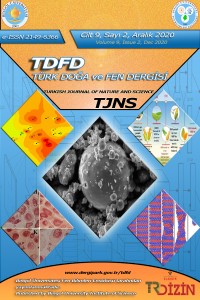Abstract
Yapılan çalışmada Konya içme suyu şebeke hattının geçtiği 39 noktada bir yıl boyunca pH, bromür, bulanıklık, toplam organik karbon ve trihalometanların analizi yapılmıştır. Bu 39 noktaya ait koordinatlar haritalar üzerinde gösterilmiştir. Mekânsal veriler, analiz sonuçları ve koordinat bilgileri ‘’ARCGIS’’ programına aktarılmıştır. Elde edilen analiz sonuçlarının aritmetik ortalaması kullanılarak, verilerin standartlara yakınlığı veya sınır değerleri aşması durumuna göre renklendirme yapılmıştır. Parametreler TS-266 ve WHO standartlarına göre değerlendirilmiş ve insan sağlığı üzerinde oluşabilecek olası yan etkileri ortaya konulmaya çalışılmıştır. Bu araştırmada, Konya ili içerisinde içme suyu şebekesi üzerinde bulunan 39 noktada pH, bromür, bulanıklık, toplam karbon ve trihalometanların oluşma potansiyelleri ile ilgili mevcut durumun ortaya konması hedeflenmiştir. Şebekenin farklı noktalarından alınan numunelerin izlenmesi sonucunda hedeflenen bileşiklerden THM bileşikleri bazı noktalarda sınır değerleri aşan seviyelerde gözlenmiştir. Toplam THM olarak incelendiğinde Hatıp Depoda (numune no:9) 1 ppm seviyesinin üstüne çıkarak sınır değeri aşmıştır. THM bileşiklerinden özellikle kloroform bileşiği, bazı aylarda şebeke noktalardan Hatıp Depo (numune no:9) ve Beybes (numune no:11)’de sınır değerleri aşmıştır. Toplam Trihalometan düzeyleri en fazla Kloroforma bağlı artış gösterirken diğer üç trihalometan bileşiğinin sınır değerlerin altında olduğu saptanmıştır.
Keywords
References
- [1] WHO (World Health Organization). Guidelines for drinking water quality. 2th ed. Geneva : 1984.
- [2] Aydın M.E, Ateş N. Konya içme suyunda trihalometanlar. Selçuk Üniversitesi Mühendislik Fakültesi Der. 2001;16(1): 1-6.
- [3] Cowman GA, Singer PC. Effect of bromide ion on haloacetic acid speciation resulting from chlorination and chloramination of aquatic humic substances. Environ Sci Technol. 1996;30(1):16 -24.
- [4] McGeehin MA, Reif JS, Becher JC, Mangione EJ. Case-control study of bladder cancer and water disinfection methods in Colorado. Am.J.Epidemiol. 1993;138(7):492 –501.
- [5] USEPA. National primary drinking water regulations: disinfectants and disinfection by-products. Final Rule Federal Register Washington DC: 1998;63(241):69390-69476.
- [6] TS–266. İçmesuyu kalite Standartları. 2019(1)
- [7] USEPA. Metot 551.1. Determination of chlorination disinfection byproducts, chlorinated solvents and halogenated pesticides/herbicides in drinking water by liquid-liquid extraction and gas chromatography: electron-capture detection -revision .Ohio:1995;(1):45268
- [8] Tongur S, Aydın ME. Adsorption kinetics of chloroform from aqueous solutions onto activated lignite. Clean Soil Air Water. 2013; 41(1): 32-36.
- [9]Golfinopoulos S. The occurrence of trihalomethanes in the drinking water in greece. Chemosphere. 2000;41(1):1761-1767.
- [10] Nikolaou AD, Lekkas TD, Golfinopoulos SK, Kostopulou MN. Application of different analytical methods for determination of volatile chlorination by-products in drinking water. Talanta. 2002;1(56):717-726.
- [11] APHA, AWWA, WEF. Standard methods for the examination of water and waste water. 19th edition Washington DC:1995 [12] Gallard H, Von Gunten U. Chlorination of natural organic matter: kinetics of chlorination and of THM formation. Water Research. 2002;36(1):65-74.
- [13] Zhang XX, Chen ZL, Shen JM. Formation and interdependence of disinfection by-products during chlorination of natural organic matter in a conventional drinking water treatment plant. Chemosphere. 2020;242(1)1-11.
Abstract
References
- [1] WHO (World Health Organization). Guidelines for drinking water quality. 2th ed. Geneva : 1984.
- [2] Aydın M.E, Ateş N. Konya içme suyunda trihalometanlar. Selçuk Üniversitesi Mühendislik Fakültesi Der. 2001;16(1): 1-6.
- [3] Cowman GA, Singer PC. Effect of bromide ion on haloacetic acid speciation resulting from chlorination and chloramination of aquatic humic substances. Environ Sci Technol. 1996;30(1):16 -24.
- [4] McGeehin MA, Reif JS, Becher JC, Mangione EJ. Case-control study of bladder cancer and water disinfection methods in Colorado. Am.J.Epidemiol. 1993;138(7):492 –501.
- [5] USEPA. National primary drinking water regulations: disinfectants and disinfection by-products. Final Rule Federal Register Washington DC: 1998;63(241):69390-69476.
- [6] TS–266. İçmesuyu kalite Standartları. 2019(1)
- [7] USEPA. Metot 551.1. Determination of chlorination disinfection byproducts, chlorinated solvents and halogenated pesticides/herbicides in drinking water by liquid-liquid extraction and gas chromatography: electron-capture detection -revision .Ohio:1995;(1):45268
- [8] Tongur S, Aydın ME. Adsorption kinetics of chloroform from aqueous solutions onto activated lignite. Clean Soil Air Water. 2013; 41(1): 32-36.
- [9]Golfinopoulos S. The occurrence of trihalomethanes in the drinking water in greece. Chemosphere. 2000;41(1):1761-1767.
- [10] Nikolaou AD, Lekkas TD, Golfinopoulos SK, Kostopulou MN. Application of different analytical methods for determination of volatile chlorination by-products in drinking water. Talanta. 2002;1(56):717-726.
- [11] APHA, AWWA, WEF. Standard methods for the examination of water and waste water. 19th edition Washington DC:1995 [12] Gallard H, Von Gunten U. Chlorination of natural organic matter: kinetics of chlorination and of THM formation. Water Research. 2002;36(1):65-74.
- [13] Zhang XX, Chen ZL, Shen JM. Formation and interdependence of disinfection by-products during chlorination of natural organic matter in a conventional drinking water treatment plant. Chemosphere. 2020;242(1)1-11.
Details
| Primary Language | Turkish |
|---|---|
| Subjects | Engineering |
| Journal Section | Articles |
| Authors | |
| Publication Date | December 30, 2020 |
| Published in Issue | Year 2020 Volume: 9 Issue: 2 |
Cite
This work is licensed under the Creative Commons Attribution-Non-Commercial-Non-Derivable 4.0 International License.


